In particle physics, as in much of the rest of physics and engineering, the practitioners are generally men. However, women do become involved and some even break through to important positions. In a series of interviews made for the Italian magazine, Newton, Paula Catapano found out more about some of the women working on different aspects of CERN’s LHC, from environmental impact and radiation safety to the complex experiments. Their answers give some idea of what makes these talented women tick, as well as an insight into their views on working in a “man’s world”.
Ana-Paula Bernades. Portuguese and French. Environmental engineer.
Thirty-five years old and the mother of a three-year-old child, Ana-Paula Bernades graduated in environmental engineering at the Grenoble Polytechnic. She arrived at CERN in 1999 and soon after started work on building safety and ergonomics. In 2003 she became section leader within CERN’s Safety Commission and has since worked on the LHC’s environmental impact, particularly on the management of acoustic disturbances generated by the sites around the 27 km ring, in collaboration with EdF. When the LHC begins operating, she will be in charge of personnel safety training and will be a consultant on general safety, acoustics and ergonomics.

Did you have any particular difficulty in working as a woman in a male-dominated environment?
Not really. Being a woman in the world of safety is an advantage. In this field it is impossible to force things, in a typically male manner, so this makes you develop negotiation techniques to convince your counterparts at CERN to invest money and time on safety issues.
Isabel Brunner. German. Radiation protection engineer.
Isabel Brunner is 33 years old and has two children aged two and four. A graduate of the Berufsakademie in Karlsruhe, she came to CERN in 1999 as the radiation protection engineer responsible for radiation protection in the SPS West Area, the RF test facilities and the n-TOF installation. Her current tasks include radiological responsibility for the SPS North Area, the RF installations in the SPS complex and the LHC. She is the radiation protection engineer responsible for the LHC injection test and will participate in the operational radiation protection of the LHC. Measurements she made during cold tests of RF modules for the LHC provided input data for the shielding at Point 4, where the RF is located.

Have you ever encountered any disadvantages/differences in your studies and career as a result of being a woman?
My answer is a clear “no”. Even during my two pregnancies – where I was not able, or allowed, to perform my work in radiation controlled areas – I can’t say that I had any disadvantages. I like my job and I have a great supervisor who treats everyone as an equal. However, working in a “man’s world” is not always easy and it needs plenty of self-esteem and force to stand up and get your point through. I’ve only had one conflict regarding gender differences, and I put an end to it when I confronted the person. This was not easy, but eventually it was the best solution to the problem.
Monique Dupont. French. Surveyor.
Monique Dupont arrived at CERN in 1978 as “industrial support” within the team looking after the topography of buildings, which at the time was expanding. Today she is a member of the metrology group, comprised of 40 people. She has worked on the alignment of magnets for each new accelerator at CERN, as well as on their realignment at each shut down. These highly accurate measurements involve the use of hi-tech instruments, often designed within the metrology group. Since 1996, she has studied and worked on the alignment for the LHC, which has more than 1800 magnet systems. To check the curvature of the magnets, the group used microprobes in the beam tube, making a measurement every 50 cm with laser technology.
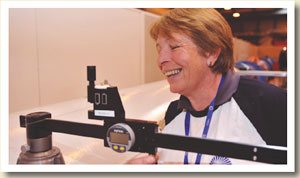
Have you experienced any difficulties as a woman working in a typically male career?
I was the only woman in a school of 1000 students. The profession did not attract women at the time – probably because the surveyor’s work is principally outside and the instruments were heavy. Nowadays modern technologies enable you to work comfortably and I think for this reason that the number of women surveyors has increased. In my group, I have always been welcomed and appreciated for my work, but maybe CERN is an exception. The environment here is so international that there are really no differences of race, culture, religion or even gender.
Fabiola Gianotti. Italian. Experimental physicist.
At 46 years old, Fabiola Gianotti is a woman who has reached one of the highest peaks during her career at CERN – that of deputy spokesperson for the largest LHC collaboration, ATLAS. She graduated at the University of Milan and completed her PhD at CERN. When physics allows, she finishes her day jogging or playing the piano – she has a professional diploma from the Milan conservatory. At the LHC, and with her experiment in particular, she would like to find dark-matter particles because of their connection with the universe. “That would be really fantastic.” She is also hoping for a surprise to come from the LHC: “Something really amazing, completely new and unexpected.”

Is it an obstacle to be a woman in a typically male career?
Physics is, unfortunately, often seen as a male subject; sterile and without charm or emotion. But this is not true, because physics is art, aesthetics, beauty and symmetry. Women have obstacles in the field for merely social reasons. Research does not allow you to make life plans. And the difficulties for women with a family are many. Something should be done, for instance, to develop more structures that would enable women with children to go through a physics career without too many obstacles, starting with nursery schools.
Virginia Greco. Italian. Electronics Engineer.
Born in the southern Italian city of Lecce, Virginia Greco is 29 and has a degree in electronics engineering from Pisa University. She is part of a team of engineers in charge of the design and installation of electronics for data acquisition in TOTEM, one of the LHC’s smaller experiments designed to focus on forward particles. Research has always been her passion and has brought her to work in many different international laboratories, from Fermilab to CERN. She also studies theatre, has worked as a radio journalist and is interested in politics, movements in ecology and international cooperation.
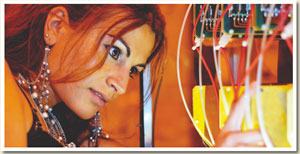
Was being a woman an obstacle in your career?
Undoubtedly. In Italy, in all technical and scientific environments, there’s a substrate of machismo. Some professors and male colleagues at my university were often convinced that, as a woman, I would never reach the level of a man, but I was never the victim of any real discrimination. In general, I think women have to make more effort than men to be taken seriously, to show they’re worth something and that they have the same skills as men. At the moment I am working in a very open international environment. I have only been here a short time and cannot make any final statements. However, I have the feeling that CERN is a meritocratic place where efficiency and productivity count more than any prejudice. But I still keep my eyes open for possible obstacles, so as not to stumble on them.
Monica Pepe Altarelli. Italian. Experimental physicist.
Monica Pepe is married to a theoretical physicist and is the mother of two children aged 18 and 13. She became a physicist almost by accident, after “risking” a career first as an actress and then as an architect. Having come to CERN with a postdoctorate research grant in 1983, she now leads a team of 60 CERN physicists in LHCb, a collaboration of 700 physicists from 48 universities in 14 countries. Her main role is to coordinate interaction between the LHCb collaboration and CERN, and to manage the manpower and financial resources of the team. In addition to this largely managerial role, she also handles the technical work of preparing the online data quality monitoring, which will be crucial for acquiring immediately full control of the quality of data collected by the detector once it sees collisions in the LHC. The only “luxuries” she can afford in her little spare time are two hours of yoga per week at lunchtime and jogging with her dog on Sundays.
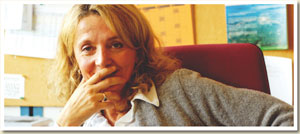
Is being a woman an obstacle for a physicist’s career?
I was never hindered in my career by the fact of being a woman. In general, I have never seen it as a problem. And from some points of view it has even been an advantage, since people tend to remember you more easily. The real difficulty is conciliating family, children and work. In my case we had to invest a lot of organizational effort, help from my family (my parents), my partner’s availability and understanding, and an important economic investment in baby sitters and carers. I’ve been lucky because both my husband and I have good positions from the same employer (CERN). But it is clear that working days are really long when you have small kids. The advantage is that working as a physicist you can afford some flexibility in organizing your time, which is very helpful. I always think that I will have to help my daughter Giulia, who has just started her architectural studies at EPFL Lausanne, the same way as my mother has helped me.
Eva Sanchez Corral. Spanish. Computer engineer.
Forty-three years old and the mother of eight-year-old twin boys, Eva Sanchez Corral gained her degree in computer engineering from the Madrid Polytechnic University in 1989. She came to CERN in 1991 as a CERN fellow and today she is one of three women in the LHC access-control group.

Any difficulty working in a predominantly male environment?
Today we are three women in the project team, and I find that extraordinary. When I arrived at CERN in 1994 I was the first “staff” woman engineer in the whole department. In the beginning, my colleagues, all men and older in general, looked at me with curiosity and even with a defiant attitude. They treated me in the way men usually treat women, rather than as a colleague. Then, little by little, the old staff were replaced by young engineers, and a few were also women. So the group started treating us as a new resource. Today, our managers especially realize that women can really make a valuable contribution to team work. We are more flexible but also more
methodical, have more energy, we are less individualistic and are good at conflict solving and negotiating. These qualities are particularly appreciated now during LHC commissioning. The real challenge for us is when children come. It’s really two jobs, and it demands a super level of organization between home and the office. Luckily they are not kids forever – they grow up and when they are older, our partners can help more.
Gilda Scioli. Italian. Experimental physicist.
Gilda Scioli is 30 years old and is from Abruzzi in central Italy. After grammar school in Lanciano, she gained a degree in physics from the University of Bologna and arrived at CERN in a postdoctoral role in the ALICE collaboration. She helped construct the complex detectors that will record the 50,000 collisions per second between lead nuclei.
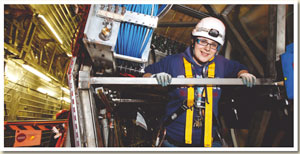
Why do you think there are more men than women in the world of physics?
Because being a researcher is not an easy profession for women. What we do can only be done here. But if I had a small child and an experiment to do, what should I do? Do I say good-bye to everybody, leave for a year and ask my husband to breast-feed the baby?
Archana Sharma. Indian. Experimental physicist.
Archana Sharma is married and has an 18-year-old son. She has a PhD in physics from Delhi University and another from Geneva University. She came to CERN in 1989 as a student in the famous Charpak–Sauli group, and after many temporary contracts, where she worked mainly on the development of particle detectors, she is now a CERN staff member within the CMS Collaboration. In CMS, she works in the Technical Coordination Group, which is in charge of integration, installation and commissioning of the experiment.
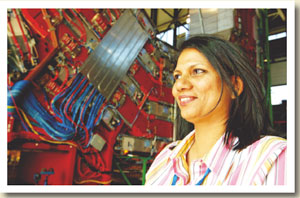
Is being a woman an advantage or a disadvantage for tackling such a big responsibility?
This job requires both a good knowledge of particle detector technology, which is my field, and also excellent communication skills to be able to interact with people from diverse countries and cultures – such as the physicists from China, Pakistan, Russia and the US. And women are natural communicators. The real challenge, however, is the juggling act: work doesn’t stop when you get home, where there’s a family to look after.
• Based on an article that first appeared in Newton (http://newton.corriere.it/inedicola.shtml).








